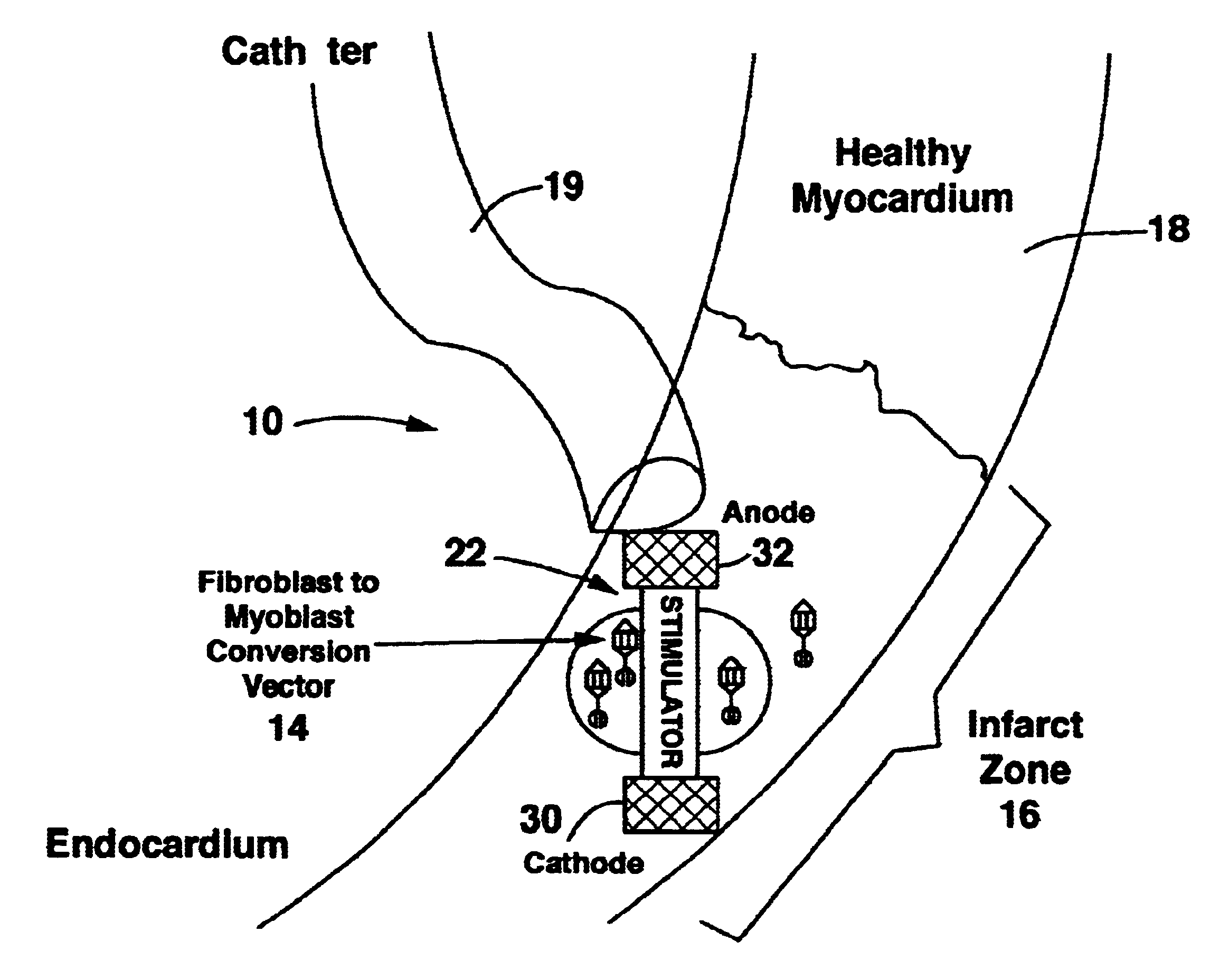Method and system for myocardial infarction repair
a myocardial infarction and repair method technology, applied in the field of myocardial infarction repair, can solve the problems of 4-6 times higher risk of heart failure, no current or proposed therapy addresses myocardial necrosis, and create electrical abnormalities, so as to reduce the amount of remodeling, increase left ventricular function, and restore elasticity and contractility to the tissue
- Summary
- Abstract
- Description
- Claims
- Application Information
AI Technical Summary
Benefits of technology
Problems solved by technology
Method used
Image
Examples
example 1
Transformation of Fibroblasts in situ and Electrical Stimulation
Adenovirus expressing myogenin (Myogen adenovirus / cDNA, which can be produced according to the method described by Murry et al., J. Clin. Invest., 98, 2209-2217 (1196)) was injected directly to the myocardium using a 100 microliter syringe. 10.sup.9 pfu (pfu-plaque forming units-one pfu is approximately 50 adenovirus particles) were diluted with saline to form a 100 microliter solution. This solution was kept on dry ice until the injection, and delivered in four equal amounts to the perimeter of the infarct zone, 90 degrees apart.
A histopathological assessment of the treated tissue was done to assess the extent of fibroblast transformation. Tissue was processed for histology and stained with H&E and Masson's Trichrome according to standard methods.
Immunohistochemical staining was also done to determine whether there was myogenin expression in the treated tissue. Eight m frozen sections were cut from the tissue, fixed, a...
example 2
Injection of Contractile Cells and Electrical Stimulation in Canines
Growth and Passage Information for Skeletal Myoblast Cells
1. Growth Medium Formulation: 81.6% M199 (Sigma, M-4530) 7.4% MEM (Sigma, M4655) 10% Fetal Bovine Serum (Hyclone, Cat.# A-1115-L) 1X (1%) Penicillin / Streptomycin (Final Conc. 100,000 U / L Pen. / 10 mg / L Strep., Sigma, P-0781).
2. Cell Passage Information: A. Seeding densities of 1.times.10.sup.4 cells / cm.sup.2 will yield an 80% confluent monolayer in approximately 96 hours. B. Split ratios of 1:4-1:6 will yield a confluent monolayer within 96 hours. C. Do not allow the cells to become confluent. Cell to cell contact will cause the cells to differentiate into myotubes.
3. Passage Information:
Flask ml of ml of Trypsin ml of Size HBSS Solution Media / Flask T-25 3 3 10 T-75 5 5 20-35 T-150 10-15 10-15 40-60 T-225 15-25 15-25 60-125 A. Remove culture medium from T-flask. B. Add back the appropriate amount of Hank's Balanced Salt Solution (HBSS). C. Incubate for approxim...
PUM
 Login to View More
Login to View More Abstract
Description
Claims
Application Information
 Login to View More
Login to View More - R&D
- Intellectual Property
- Life Sciences
- Materials
- Tech Scout
- Unparalleled Data Quality
- Higher Quality Content
- 60% Fewer Hallucinations
Browse by: Latest US Patents, China's latest patents, Technical Efficacy Thesaurus, Application Domain, Technology Topic, Popular Technical Reports.
© 2025 PatSnap. All rights reserved.Legal|Privacy policy|Modern Slavery Act Transparency Statement|Sitemap|About US| Contact US: help@patsnap.com



